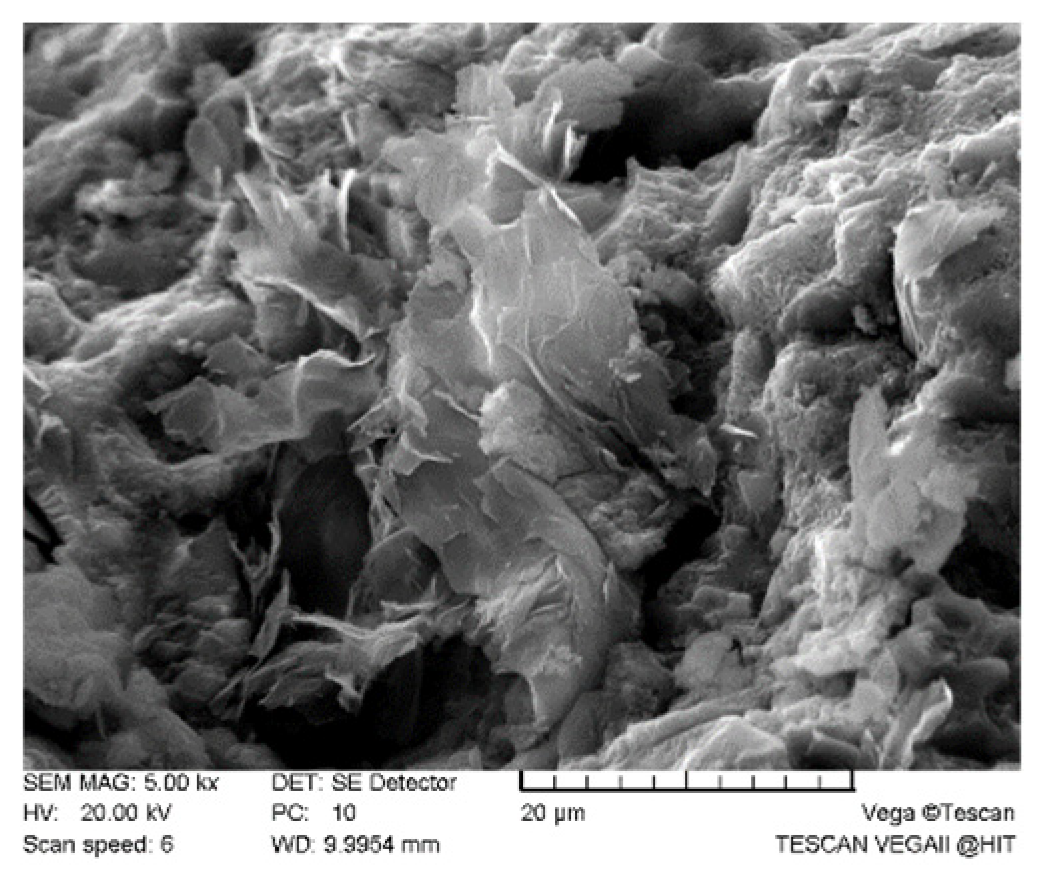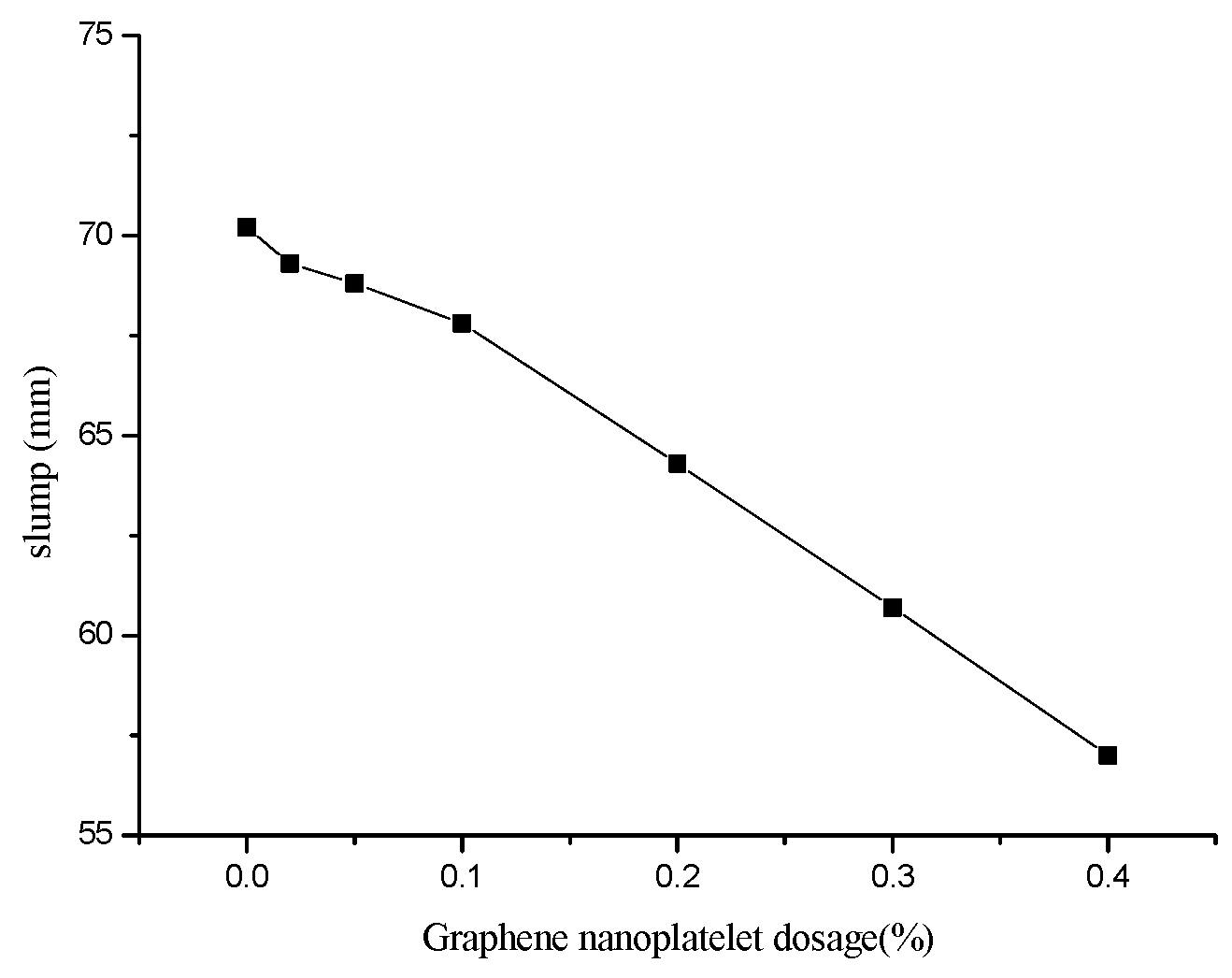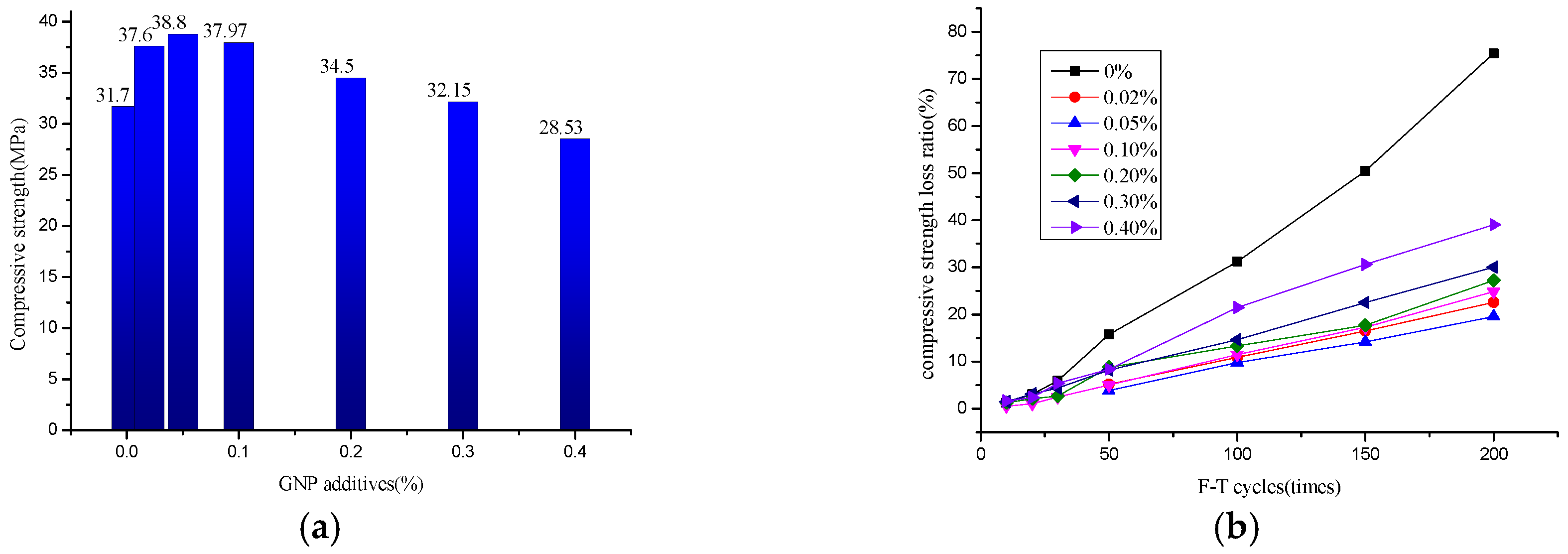Graphene Nanoplatelets Impact on Concrete in Improving Freeze-Thaw Resistance
Abstract
1. Introduction
2. Experimental Program
2.1. Material and Specimen Preparation
2.2. Methods
2.2.1. Scanning Electron Microscopy
2.2.2. Workability
2.2.3. Mass Loss
2.2.4. Compressive Strength
3. Results and Discussion
3.1. Scanning Electron Microscopy
3.2. Workability
3.3. Visual Assessment
3.4. Mass Change
3.5. Compressive Strength Evolution
3.6. Elastic Modulus Evolution
3.7. Peak Strain Change
4. Conclusions
- (1)
- The SEM micrographs indicate that the effect of GNP enhanced the freeze-thaw resistance of concrete. It can be concluded that graphene nanoplatelets with the appropriate additional acts effectively in enhancing the durability of concrete under freezing-thawing cycles.
- (2)
- Adding graphene nanoparticles could reduce the workability of graphene concrete, and the slump of the specimen decreases with the increasing nanoparticles addition.
- (3)
- Concrete with GNP displayed less mass loss during F-T actions, particularly the concrete with the 0.05% GNP addition. In addition, GNP concrete exhibited fewer damages on the sample’s surfaces than the control concrete.
- (4)
- Adding graphene nanoparticles up to 0.3% could improve the compressive strength of concrete; before F-T test, the maximum increase of compressive strength in GC0.05 relative to that of GC0 was 22.40%. However, above 0.4%, the incorporation of GNP had a negative influence on enhancing the compressive strength of concrete. Furthermore, concrete with the appropriate additional GNP showed less compressive strength loss after 200 F-T cycles compare to the control specimens.
Author Contributions
Funding
Acknowledgments
Conflicts of Interest
References
- Fan, Y.; Zhang, S.; Wang, Q.; Shah, S.P. Effects of nano-kaolinite clay on the freeze–thaw resistance of concrete. Cem. Concr. Compos. 2015, 62, 1–12. [Google Scholar] [CrossRef]
- Du, H.; Du, S.; Liu, X. Durability performances of concrete with nano-silica. Constr. Build. Mater. 2014, 73, 705–712. [Google Scholar] [CrossRef]
- Mukharjee, B.B.; Barai, S.V. Statistical techniques to analyze properties of nano-engineered concrete using Recycled Coarse Aggregates. J. Clean. Prod. 2014, 83, 273–285. [Google Scholar] [CrossRef]
- Stynoski, P.; Mondal, P.; Marsh, C. Effects of silica additives on fracture properties of carbon nanotube and carbon fiber reinforced Portland cement mortar. Cem. Concr. Compos. 2015, 55, 232–240. [Google Scholar] [CrossRef]
- Li, H.; Xiao, H.; Guan, X.; Wang, Z.; Yu, L. Chloride diffusion in concrete containing nano-TiO2 under coupled effect of scouring. Compos. Part. B Eng. 2014, 56, 698–704. [Google Scholar] [CrossRef]
- Shahrajabian, F.; Behfarnia, K. The effects of nano particles on freeze and thaw resistance of alkali-activated slag concrete. Constr. Build. Mater. 2018, 176, 172–178. [Google Scholar] [CrossRef]
- Lv, S.; Ma, Y.; Qiu, C.; Sun, T.; Liu, J.; Zhou, Q. Effect of graphene oxide nanosheets of microstructure and mechanical properties of cement composites. Constr. Build. Mater. 2013, 49, 121–127. [Google Scholar] [CrossRef]
- Du, H.; Pang, S.D. Enhancement of barrier properties of cement mortar with graphene nanoplatelet. Cem. Concr. Res. 2015, 76, 10–19. [Google Scholar] [CrossRef]
- Mingli, C.; Huixia, Z.; Cong, Z. Effect of graphene on mechanical properties and microstructure of cement paste. J. Harbin. Inst. Technol. 2015, 47, 26–30. [Google Scholar]
- Pan, Z.; He, L.; Qiu, L.; Korayem, A.H.; Li, G.; Zhu, J.W.; Collins, F.; Li, D.; Duan, W.H.; Wang, M.C. Mechanical properties and microstructure of a graphene oxide–cement composite. Cem. Concr. Compos. 2015, 58, 140–147. [Google Scholar] [CrossRef]
- Wang, Q.; Wang, J.; Lu, C.-X.; Liu, B.-W.; Zhang, K.; Li, C.-Z. Influence of graphene oxide additions on the microstructure and mechanical strength of cement. New Carbon Mater. 2015, 30, 349–356. [Google Scholar] [CrossRef]
- Du, H.; Gao, H.J.; Pang, S.D. Improvement in concrete resistance against water and chloride ingress by adding graphene nanoplatelet. Cem. Concr. Res. 2016, 83, 114–123. [Google Scholar] [CrossRef]
- Gong, K.; Pan, Z.; Korayem, A.H.; Qiu, L.; Collins, F.; Wang, C.M.; Duan, W.H. Reinforcing Effects of Graphene Oxide on Portland Cement Paste. J. Mater. Civ. Eng. 2016, 27, A4014010. [Google Scholar] [CrossRef]
- Ming-li, C.; Hui-xia, Z.; Cong, Z. Effect of graphene on mechanical properties of cement mortars. J. Cent. South Univ. 2016, 23, 919–925. [Google Scholar]
- Mohammed, A.; Sanjayan, J.G.; Duan, W.H.; Nazari, A. Graphene Oxide Impact on Hardened Cement Expressed in Enhanced Freeze–Thaw Resistance. J. Mater. Civ. Eng. 2016, 28, 1–6. [Google Scholar] [CrossRef]
- Tong, T.; Fan, Z.; Liu, Q.; Wang, S.; Tan, S.; Yu, Q. Investigation of the effects of graphene and graphene oxide nanoplatelets on the micro- and macro-properties of cementitious materials. Constr. Build. Mater. 2016, 106, 102–114. [Google Scholar] [CrossRef]
- Li, X.; Lu, Z.; Chuah, S.; Li, W.; Liu, Y.; Duan, W.H.; Li, Z. Effects of graphene oxide aggregates on hydration degree, sorptivity, and tensile splitting strength of cement paste. Compos. Part. A Appl. Sci. Manuf. 2017, 100, 1–8. [Google Scholar] [CrossRef]
- Xu, J.; Zhang, D. Pressure-sensitive properties of emulsion modified graphene nanoplatelets/cement composites. Cem. Concr. Compos. 2017, 84, 74–82. [Google Scholar] [CrossRef]
- Wang, B.; Zhao, R. Effect of graphene nano-sheets on the chloride penetration and microstructure of the cement based composite. Constr. Build. Mater. 2018, 161, 715–722. [Google Scholar] [CrossRef]
- Liu, J.; Li, Q.; Xu, S. Reinforcing Mechanism of Graphene and Graphene Oxide Sheets on Cement-Based Materials. J. Mater. Civ. Eng. 2019, 34, 1–9. [Google Scholar] [CrossRef]
- Yang, H.; Cui, H.; Tang, W.; Li, Z.; Han, N.; Xing, F. A critical review on research progress of graphene/cement based composites. Compos. Part. A Appl. Sci. Manuf. 2017, 102, 273–296. [Google Scholar] [CrossRef]
- China National Standard. Standard for Test Methods of Mechanical Properties on Ordinary Concrete (GB/T50081-2002); China Architecture and Building Press: Beijing, China, 2002. [Google Scholar]
- China National Standard. Standard for Test Methods of Long-Term Performance and Durability of Ordinary Concrete (GB/T 50082-2009); China Architecture and Building Press: Beijing, China, 2009. [Google Scholar]







| Composition | CaO | SiO2 | Al2O3 | Fe2O3 | SO3 | MgO | Loss | Of Ignition |
|---|---|---|---|---|---|---|---|---|
| Content (%) | 63.79 | 22.6 | 4.62 | 3.26 | 2.29 | 1.70 | 3.14 |
| Cycles | GNP Additives | ||||||
|---|---|---|---|---|---|---|---|
| 0% | 0.02% | 0.05% | 0.1% | 0.2% | 0.3% | 0.4% | |
| 0 |  |  |  |  |  |  | |
| 30 |  | — | — |  |  |  |  |
| 50 |  |  |  |  |  |  |  |
| 150 |  |  |  |  |  |  |  |
| 200 |  |  |  |  |  |  |  |
| F-T Cycles | GC0 | GC0.02 | GC0.05 | GC0.1 | GC0.2 | GC0.3 | GC0.4 |
|---|---|---|---|---|---|---|---|
| 0 | 30.895 | 35.593 | 36.060 | 35.485 | 33.740 | 31.900 | 30.355 |
| 10 | 29.445 | - | - | 34.010 | 33.490 | 31.445 | 29.830 |
| 20 | 29.375 | - | - | 32.415 | 33.215 | 30.655 | 29.395 |
| 30 | 28.265 | - | - | 32.790 | 31.840 | 30.835 | 29.190 |
| 50 | 28.295 | 32.019 | 33.420 | 31.755 | 30.410 | 30.430 | 27.550 |
| 100 | 26.700 | 31.440 | 32.670 | 30.380 | 29.865 | 28.575 | 25.560 |
| 150 | 25.175 | 29.375 | 30.393 | 28.825 | 28.210 | 27.835 | 25.060 |
| 200 | 23.045 | 28.460 | 29.725 | 28.140 | 27.080 | 26.665 | 23.315 |
| F-T Cycles | GC0 | GC0.02 | GC0.05 | GC0.1 | GC0.2 | GC0.3 | GC0.4 |
|---|---|---|---|---|---|---|---|
| 0 | 0.00188 | 0.00224 | 0.00232 | 0.00229 | 0.00220 | 0.00209 | 0.00189 |
| 10 | 0.00194 | - | - | 0.00236 | 0.00214 | 0.00203 | 0.00185 |
| 20 | 0.00178 | - | - | 0.00217 | 0.00214 | 0.00199 | 0.00180 |
| 30 | 0.00175 | - | - | 0.00195 | 0.00207 | 0.00195 | 0.00184 |
| 50 | 0.00173 | 0.00187 | 0.00192 | 0.00185 | 0.00184 | 0.00174 | 0.00167 |
| 100 | 0.01051 | 0.00163 | 0.00171 | 0.00161 | 0.00158 | 0.00154 | 0.00158 |
| 150 | 0.00152 | 0.00156 | 0.00166 | 0.00157 | 0.00161 | 0.00151 | 0.00154 |
| 200 | 0.00139 | 0.00152 | 0.00164 | 0.00151 | 0.00147 | 0.00144 | 0.00133 |
© 2019 by the authors. Licensee MDPI, Basel, Switzerland. This article is an open access article distributed under the terms and conditions of the Creative Commons Attribution (CC BY) license (http://creativecommons.org/licenses/by/4.0/).
Share and Cite
Chen, G.; Yang, M.; Xu, L.; Zhang, Y.; Wang, Y. Graphene Nanoplatelets Impact on Concrete in Improving Freeze-Thaw Resistance. Appl. Sci. 2019, 9, 3582. https://doi.org/10.3390/app9173582
Chen G, Yang M, Xu L, Zhang Y, Wang Y. Graphene Nanoplatelets Impact on Concrete in Improving Freeze-Thaw Resistance. Applied Sciences. 2019; 9(17):3582. https://doi.org/10.3390/app9173582
Chicago/Turabian StyleChen, Guofang, Mingqian Yang, Longjun Xu, Yingzi Zhang, and Yanze Wang. 2019. "Graphene Nanoplatelets Impact on Concrete in Improving Freeze-Thaw Resistance" Applied Sciences 9, no. 17: 3582. https://doi.org/10.3390/app9173582
APA StyleChen, G., Yang, M., Xu, L., Zhang, Y., & Wang, Y. (2019). Graphene Nanoplatelets Impact on Concrete in Improving Freeze-Thaw Resistance. Applied Sciences, 9(17), 3582. https://doi.org/10.3390/app9173582





